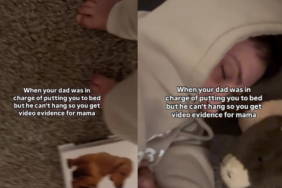Have you heard of Ferber Method? Right before my newborn twins turned 4-months-old, they went into this horrible nighttime sleep spiral, and would wake up every half hour, starting at 2 a.m. They didn’t want a bottle. They didn’t want to be soothed. They just wanted their pacifiers popped back into their mouths. It was horrible, not only for me, who was so exhausted I often wondered if I should actually be caring for children, but also for my boys. Their moods changed, they were constantly crying, and they weren’t eating well. It’s like they’d gone from easy babies to fussy babies, literally overnight. As it turned out, their lack of satisfying, rejuvenating nighttime sleep had totally messed them up.
So, at their monthly checkup, my pediatrician recommended that we do some form of sleep training. On one hand, I knew it had to be done, and had several friends who told me it was a life-changer. On the other hand, I worried if letting my babies cry themselves to sleep in a dark room was cruel and unusual punishment. Here’s what my doctor said to me though, in a nutshell: Lack of sleep and poor sleep habits are extremely unhealthy for babies, and that this constant waking was not good for them. Helping them to self-soothe at night would set them up for a lifetime of healthy sleep habits, and they were ready now.
Although it was rough, super rough, we did a modified Ferber method, and it was one of the best parenting decisions I’ve ever made. It took several nights of, yes, pure torture, but now, five years later, my boys are champion sleepers. We turn out the lights, they bop around for a bit, and then they fall asleep in their own beds, and don’t wake up until the morning.
Of course, people have widely varying opinions on sleep training; some studies say it’s the best, others say it’s evil. I absolutely respect the opinions of those who decide sleep training is not for their family, but I also wonder if they’re not fully informed about what it entails. Despite what many think, it’s not about just letting a baby cry and wail for hours on end, totally ignored and neglected by his parents. There’s a true method, and it works!
I reached out to Natalie Willes, certified infant sleep consultant at BabySleepTrainer.com, to find out more about the controversial sleep training method…
What is the Ferber method?
Back in the ’80s, Richard Ferber, MD, published a book called Solve Your Child’s Sleep Problems, in which the pediatrician outlined a method to help solve baby’s sleep problems; it was designed on the premise of helping your baby learn to soothe himself back to sleep. Although controversial, his method, often referred to as “Ferberizing” and “crying it out,” is actually far more gentle than many believe. See, babies and adults both have sleep cycles, and we wake up every 60 to 90 minutes over the course of the night. Thing is, we adults don’t even realize it and are able to fall back asleep easily. But babies don’t know how! If you cuddle your baby to bed, then she wants you when she wakes up at 2 a.m. If her pacifier was in her mouth, she wants the pacifier. “Whatever association that your child has to go to sleep at bedtime, whether it’s a pacifier or you cuddling them, they’ll then need to have that same environment when they wake up in the middle of the night,” explains Wiles. “So the premise of the Ferber method is to put them to bed exactly how they will wake up in the middle of the night. If they learn to fall asleep on their own, they can do the same when they wake up later.”
How do you do the Ferber method?
On the first night that you start the Ferber method, you put your baby into his crib awake and alone, without a pacifier. Then, you kiss him goodnight and you leave the room. Yes, he’s going to cry, so you go back in a few minutes later and reassure him with your voice, “You’re okay, Mommy’s here, go to sleep.” It’s not recommended that you touch the baby as it will only engage him more, and keep him awake. “You’re there to reassure him and yourself, but not to make him stop crying,” says Wiles. “He’s likely to cry more when you leave the room again, so think of these as just check-ins.” Then, you’ll wait about 5 minutes, go in again. Then, you’ll wait about 10 minutes, go in again. And you’ll keep going in every 10 minutes until he ultimately falls asleep.
On the second night, you’ll start with a longer wait time, usually about 5 minutes. Then, you’ll go in at ten minutes, then 12. The third night, you might go in at 12 minutes, then 15, and so on. It’s called “progressive waiting,” and the object is to stretch out the length of time between your check-ins.
Wiles also recommends doing sleep training for naps. “I’ve found that sleep training at bedtime will only work if you’re also doing it for naps,” she says. “If not, your baby may start waking up again about 10 or 11 days after you started the sleep training. It needs to be consistent, at daytime and nighttime.”
Is the Ferber method harmful to babies?
While some research suggests that sleep training can cause emotional damage in the long-term, the American Academy of Pediatrics has stated that sleep training is “effective and safe” for babies. So you really have to just make your own determination about what’s best for your child and your family. Here are a couple of things to keep in mind though:
1. Your baby’s cries are harder on you than they are on her. “It’s been biologically researched that when a mother hears her baby’s cry, she has a fear response,” says Wiles. “She’s hearing what emotionally sounds like a scream, even though it’s just your child’s way of calling to you. Although you have a strong biological drive to stop the crying, it doesn’t mean she’s in pain or suffering, or that anything is wrong.”
2. Getting a solid night’s sleep is best for your child. If sleep training is the answer to your baby being well rested, then you’re doing the healthiest thing for your child. Ultimately, they won’t like eating vegetables or brushing their teeth either, but you know that it’s good for them. “When your baby cries, she’s telling you that she doesn’t want to go to sleep alone, or that she wants her pacifier — that’s what she’s communicating,” says Wiles. “You can reassure yourself though by remembering that you know what is happening, why you’re doing this, and that it’s for a good reason which will ultimately be beneficial for her.”
Does the Ferber method work?
Yes, and many parents (like me) swear by it. Diana G. of Cape Coral, Florida, says that she chose not to sleep train her older daughter, but when her son came along, she knew she had to do something to help him sleep. “He was waking up every two hours to nurse, and I was so exhausted, I thought I was going to die,” she says. “So when he was 8-months-old, I started Ferberizing. It took three days, and he now sleeps 13 hours, in his own bed, every night. Meanwhile, my older daughter still sleeps in bed with us and has so many sleep problems. Without a doubt, it was the right thing to do and I wish I had done the same for my daughter. Now it’s too late.”
Amber W., from Los Angeles, agrees with Diana G. “It was the best thing I ever did! I was at a breaking point and couldn’t deal with my twins not sleeping anymore,” she says. “Instead of getting better, their sleep kept getting worse, and they were waking up every 1.5-2 hours, whenever the pacifier would fall out. When they were about 4.5 months old, we weaned them off the night feedings, got rid of the pacifiers and sleep sacks, and started with the Ferber method. It took about a week for them to start sleeping 8 to 10 hours straight, and by a month, they were sleeping 12 hours a night.”
What else should parents know about the Ferber method?
The key to making it work is consistency. As Wiles points out, once you make the decision to do any kind of sleep training, like the Ferber method, you have to stick with it and keep going, no cheating. You go in and start cuddling him on night #2 and you’ll have to start all over again. “Not only that, but it’s confusing and unfair to the baby,” she adds.
If done correctly, Wiles says you should see about 80 to 100 percent improvement in your child’s sleep after just two to three nights, and in one to two weeks you will see the same improvements in their naps (which can be trickier).
Again though, every mother is gifted with her own instincts about what is best for her child. Talk to friends, talk to your doctor, and ultimately, go with your gut. Only you can decide what’s best for your baby, but if you choose to Ferberize, know that you’ll be gifting your child with a lifetime of healthy sleep habits.
Photo: Getty








